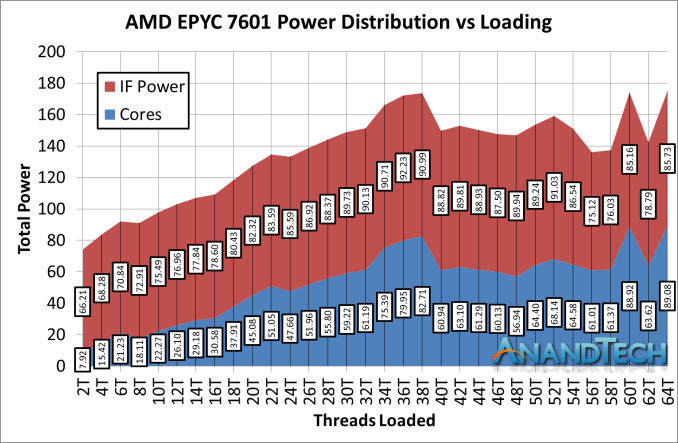ICELAKE_D is probably:
INTEL_ICELAKE_D is for XEON-D products.
For example ICELAKE_L are existing mobile Icelake products like 1065G7 that have extended model 7E.
Desktop is INTEL_FAM6_ICELAKE, extended model 0x7D
ICELAKE_D is probably:
More Icelake benchmarks in Linux from Phoronix. Seems Firefox in Linux seems to love Icelake.
For the more knowledgeable folk
Not a knowledgeable folk, I say you can compare AnandTech's SPEC2006 results.
Yeah I've seen all those, but I have next to no knowledge about the Spec benchmark. I know it's an industry benchmark, but as to how it translates to actual performance in consumer workloads, I have no idea.
That's why I wanted some feedback from the forum experts. Honestly, I'm not a big fan of Apple at all so it irritates me that they are beating Intel and AMD in microarchitecture performance. I at least want to know that Intel isn't taking it laying down

looks like a damned good part!
?Yeah I've seen all those, but I have next to no knowledge about the Spec benchmark. I know it's an industry benchmark, but as to how it translates to actual performance in consumer workloads, I have no idea.
They are very good in single core / low core counts.
?
All the workloads in SPEC are based on real-world applications, some of which include consumer workloads - like gcc, h264, povray etc.
SPEC is supposed to be portable which means no intrinsics or assembly. Your only hope to see SIMD instructions being used is if the compiler could identify some vectorizable code.Yes but it doesn't tell you everything unless you are very familiar with it. For example, is the h264 benchmark in Spec optimized for modern SIMD instructions or is it running in scalar mode only?
On hand-written SIMD code I'd indeed expect the 9900K to lead due to the width of AVX2. But the end-user apps where this would make a difference is likely not that large.If it's not SIMD optimized, I suppose that would explain a lot, like how the A13 could match the 9900K . I'm assuming the benchmark came out in 2006, so it's very old and does not use advanced SIMD instructions like AVX2.
Furthermore, keep in mind that x264 is not 100% assembly code. About half of x264's running
time is spent in either optimized C code or mostly-non-SIMD assembly code, where AVX2 will not
provide any gains. Even if all the SIMD assembly functions doubled in speed, x264 would only get
33% faster because of this bottleneck.
SPEC is supposed to be portable which means no intrinsics or assembly. Your only hope to see SIMD instructions being used is if the compiler could identify some vectorizable code.
On hand-written SIMD code I'd indeed expect the 9900K to lead due to the width of AVX2. But the end-user apps where this would make a difference is likely not that large.
Different OS and compilers. The Intel compiler gives better results than gcc by about 10 percent.Now in Anandtech's testing, the 9900K scored 80.36, which is nowhere near what you'd expect considering the 9900K has a much higher single core clock speed than the 6700K; 5ghz vs 4.2ghz at stock clocks.
The Intel compiler is better for some of the SPEC subtests; sometimes it's close to pure cheating (quantum) but in the case of h264 I would not be surprised that it could be due to better vectorization by icc.I was doing some digging on Spec's website, looking at the different scores for various submitted results. For the 6700K, the highest score I could find for the h264 benchmark was 79.2.
Now in Anandtech's testing, the 9900K scored 80.36, which is nowhere near what you'd expect considering the 9900K has a much higher single core clock speed than the 6700K; 5ghz vs 4.2ghz at stock clocks.
So this of course, makes me very suspicious, that the benchmark itself just doesn't scale well.
EDIT: looked this up; the gain on h264 by icc is also in part due to the use of automatic reduction of pointers to 32-bit (the -auto-p32 option). According to David Kanter that option brings 10-20% gain on that test.
That's not pointer math that matters, that's pointer being stored in the caches that are twice larger resulting in more cache thrashingGeez, that’s a surprisingly large gain just from a reduction in pointer width. There must be an unusually large amount of pointer math being done.
Ah, thanks - I was trying to figure out how to make sense of this.That's not pointer math that matters, that's pointer being stored in the caches that are twice larger resulting in more cache thrashing
The Intel compiler is better for some of the SPEC subtests; sometimes it's close to pure cheating (quantum)

out of eleven announced Ice Lake U CPUs just few are available in etail/retail. They haven't even bothered to add the i7-1068G7 to their Ark DB.
This timing doesn't inspire too much confidence. Intel might as well skip their 10nm node altogether since it still doesn't quite work
Icelake Server is not using the same core from Icelake Client. Server core is using SunnycoveX which might have more AVX512 units than even the client model.About Ice lake-SP....it is known since ages that ICL-SP is some of a lower end server generation because of the 10nm issues, in fact the 38C confirmation is a nice surprise, some time ago we thought Icelake-SP tops out at only 26C. The big 10nm server thing is coming with Sapphire Rapids.


